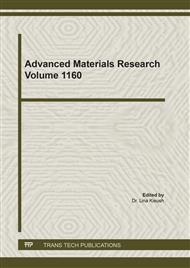[1]
M. Stewart and O. T. Lewis,. History and Organization of Codes, in Pressure Vessel Field. Manual. Elsevier, 2013, p.1–48.
Google Scholar
[2]
T. Williams and R. Nanstad,. Low-alloy steels, in Structural Alloys for Nuclear Energy Applications. Elsevier, 2019, pp.411-483.
DOI: 10.1016/b978-0-12-397046-6.00010-1
Google Scholar
[3]
ASTM A517 / A517M: Standard Specification for Pressure Vessels Plates, Alloy Steel, High-Strength, Quenched and tempered.
DOI: 10.1520/a0517_a0517m-06
Google Scholar
[4]
ASM Metalhandbook Volume 1: Properties and Selection Ferrous Alloys and Special Purpose Materials. tenth ed. ASM International, USA, (1993).
Google Scholar
[5]
R. E. Smallman and A. H. W. Ngan., Physical Metallurgy and Advanced Materials, Seventh edt. India, (2007).
Google Scholar
[6]
W. J. Nam and H. C. Choi,. Effect of Si on mechanical properties of low alloy steels. Mater. Sci. Technol., 15 (5) (1999) 527–530.
Google Scholar
[7]
I. Vorel, S. Jenicek, J. Kana, K. Ibrahim, V. Kotesovec, B. Masek,. Effect of silicon content on microstructure of low-alloy Q&P-processed steel, IOP Conf.: Mater. Scie. Eng., 179 (2017) 1-7.
DOI: 10.1088/1757-899x/181/1/012035
Google Scholar
[8]
M. Bohuslav, J. Hana, H. Daniela, K. Ludmila, and K. Danuše,. The Effect of Mn and Si on the properties of advanced high strength steels processed by quenching and partitioning, Mater. Sci. Forum, 654–656 (2010) 94–97.
DOI: 10.4028/www.scientific.net/msf.654-656.94
Google Scholar
[9]
R. C. Giacomin and B. A. Webler, Effect of silicon on AHSS as-cast microstructure development and properties. ISIJ Int., 59 (2018) 858–864.
DOI: 10.2355/isijinternational.isijint-2018-598
Google Scholar
[10]
J. Drumond, O. Girina, J. F. da Silva Filho, N. Fonstein, and C. A. S. de Oliveira,. Effect of Silicon Content on the Microstructure and Mechanical Properties of Dual-Phase Steels, Metallogr. Microstruct. Anal., 1 (2012) 217–223.
DOI: 10.1007/s13632-012-0034-8
Google Scholar
[11]
K. Arimoto, F. Ikuta, T. Horino, S. Tamura, M. Narazaki, and Y. Mikita,. Preliminary study to identify criterion for quench crack prevention by computer simulation, Transactions Mater. Heat Treat., 25 (5) (2004) 486–493.
Google Scholar
[12]
A. K. Sinha, and B. P. Division,. Defects and Distortion in Heat-Treated Parts, ASM Handbook : Heat Treat. Metallography, (4) (1991) 601–619.
Google Scholar
[13]
N. I. Kobasko,. The development of quench cracks in steel, Met. Sci. Heat Treat., 12 (11) (1970) 900–901.
DOI: 10.1007/bf00653381
Google Scholar
[14]
S. Šolić, B. Podgornik, and V. Leskovšek,. The occurrence of quenching cracks in high-carbon tool steel depending on the austenitizing temperature, Eng. Fail. Anal., 92 (2018) 140–148.
DOI: 10.1016/j.engfailanal.2018.05.008
Google Scholar
[15]
S. Mackenzie and H. International,. Overview of the Mechanisms of Failure in Heat Treated Steel Components, Fail. Anal. Heat Treat. Steel Components, (2020) 43–86.
DOI: 10.31399/asm.tb.fahtsc.t51130043
Google Scholar
[16]
S. Zhou, K. Zhang, N. Chen, J. Gu, and Y. Rong,. Investigation on high strength hot-rolled plates by quenchingpartitioning- Tempering process suitable for engineering, ISIJ Int., 51(10) (2011) 1688–1695.
DOI: 10.2355/isijinternational.51.1688
Google Scholar


